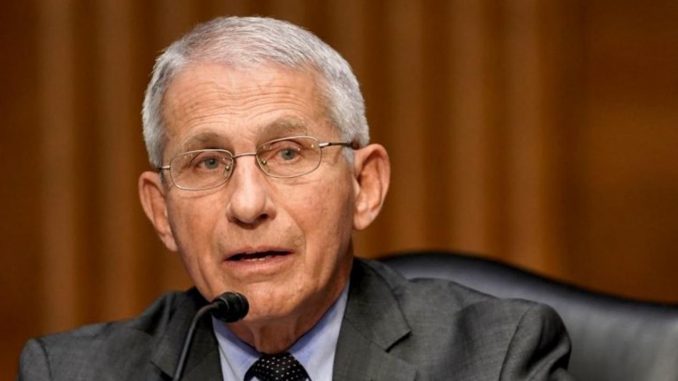
The highly transmissible delta variant has been officially confirmed in all 50 states as of this week, and health officials nationwide are raising alarms about localized coronavirus outbreaks as the Fourth of July weekend arrives.
The Centers for Disease Control and Prevention (CDC) estimates the strain makes up about a quarter of U.S. cases, with top infectious diseases expert Anthony Fauci calling it the “greatest threat” to getting rid of COVID-19.
Amid the variant’s spread, the country recorded a 10 percent increase in its seven-day average this week, although the average is 95 percent lower than the U.S.’s early January peak, CDC Director Rochelle Walensky said in a Thursday briefing.
Administration officials have warned that unvaccinated people, including young people and children, are most at risk to contract the delta strain and experience serious illness, as the vaccine remains effective against the currently circulating variants.
Former Food and Drug Administration (FDA) Commissioner Scott Gottlieb told CNBC on Friday that most parts of the county are “relatively safe” with high vaccination rates, although other areas “should exercise more caution.”
"Vaccinations are high in many parts of the country. I don't think people really should be concerned to gather with family this July 4," says @ScottGottliebMD. "Missouri, parts of Nevada, Arkansas, Oklahoma–I think people should exercise more caution." pic.twitter.com/cWhjd7Rtg9
— Squawk Box (@SquawkCNBC) July 2, 2021
Here are five states in particular where the delta variant is spreading and cases are rising, potentially signaling an upcoming increase in hospitalizations and deaths.
Missouri
The Show-Me State has made headlines in recent weeks as COVID-19 cases have surged there, where less than half of adults are fully vaccinated.
Missouri reached 1,383 new cases on Thursday, as its average daily case count increased by 55 percent over two weeks. It ranks as the second in the country with the most new COVID-19 cases per capita at 15.1 per 100,000 people, according to Covid Act Now.
Officials and experts have attributed the ongoing rise in cases and hospitalizations to the growing prevalence of the delta strain, which has exponentially risen to make up a majority of COVID-19 cases in the state in recent months.
“Unfortunately, the arrival of the Delta variant in Missouri is driving transmission of the virus, and is resulting in increased illness and hospitalization among a younger population and the unvaccinated,” Missouri Hospital Association President and CEO Herb Kuhn said in a statement, calling it a “tragic consequence.”
Among the hot spots in the state are Greene County, home to Springfield, and St. Louis County, where average daily cases boosted by 55 percent and 61 percent, respectively, in two weeks, according to The New York Times.
The St. Louis County and city health departments in response advised on Thursday for all people to wear a mask indoors where others’ vaccination statuses are unknown. Nearby Jefferson County released similar guidance, citing a 42 percent increase in cases with most among 10- to 19-year-olds.
Los Angeles County had first issued that recommendation, straying from CDC guidance that fully vaccinated people do not need masks in most situations.
Arkansas
Arkansas’s COVID-19 case count reached its highest level since the winter on two consecutive days this week, with 686 and 700 new cases confirmed Wednesday and Thursday.
The surge has led to a rise in cases in almost every county, with the whole state seeing an 81 percent increase in its average daily cases in two weeks. Arkansas also ranks third for the most daily new cases per capita at 14.8 cases per 100,000 people.
State officials, including Gov. Asa Hutchinson (R), have blamed the delta strain and pleaded with residents to get their COVID-19 shots to boost the state’s vaccination rate, which stands at 43.4 percent of adults.
“The high number of cases today makes it clear that the Delta Variant is increasing the spread of the virus,” Hutchinson tweeted on Wednesday.
The high number of cases today makes it clear that the Delta Variant is increasing the spread of the virus. The good news is that vaccinations increased to over 10,000. Let’s keep making progress. pic.twitter.com/M7UqHxxm6b
— Gov. Asa Hutchinson (@AsaHutchinson) June 30, 2021
University of Arkansas for Medical Sciences Chancellor Cam Patterson said during a briefing that the delta variant makes up more than 25 percent of cases in the state, and he expects it will become the dominant strain in a week or two.
“We have to be concerned that this would be a trend that could continue, and if it does, it would appear that we may be in the beginning of the third surge of COVID-19 here in the state of Arkansas,” he said.
Nevada
Nevada has seen its COVID-19 case count skyrocket since mid-June, reaching Missouri’s levels in a few weeks. The state documented 543 new COVID-19 cases on Thursday in a 48 percent increase in a week.
Whereas most of the US is doing well, Nevada has joined Missouri in becoming the epicenter of the Delta variant hit. Both states are now Delta dominant and have rising cases and hospitalizations (~50% and 20%, respectively, past 2 weeks) pic.twitter.com/QytkeOPjeV
— Eric Topol (@EricTopol) June 27, 2021
But its daily average for cases at 492 marked a 114 percent increase within two weeks, according to data from the Times.
Nevada has climbed to the top state for most daily new cases per capita with 16 per 100,000 people.
The majority of Nevada’s new cases are being confirmed in Clark County, where Las Vegas is located. The county, which has a daily average of 453 new cases, has seen a 146 percent increase in that average over two weeks, Times data shows.
Statewide, the delta strain made up 46.22 percent of sequenced COVID-19 samples in the two-week period ending in June 25, overtaking the previously dominant alpha variant, according to a report.
In response, Gov. Steve Sisolak (D) announced the state would seek federal assistance to combat the escalation of COVID-19 cases after the White House declared it would send “surge teams” to hotspots nationwide.
“We must continue to leverage resources at the federal, state and local level to increase access and confidence and get as many Nevadans protected from this deadly virus as possible,” he said in a statement.
Colorado
Colorado is another state where the delta variant appears to be spreading, although the rises seem to be more limited to certain areas.
The most recent data from sequencing a random sample found 70 percent of cases derived from the delta strain, Jessica Bralish, the director of communications at the Colorado Department of Public Health and Environment, told The Hill.
As a whole, Colorado is actually seeing a slight drop in overall COVID-19 cases with a 24 percent decrease in its average daily case count within two weeks.
But Mesa County, home to Grand Junction, has been struck by new COVID-19 cases in recent days with an average of 48 cases per day in a 34 percent increase from two weeks prior, according to Times data.
The county, which hosted thousands last weekend for the County Jam music festival, has seen its hospitals fill up with 98.3 percent of beds and 90.9 percent of ICU beds in use.
Mesa County officials issued a public health advisory on Wednesday, calling vaccination “critically important as case counts continue to be at a sustained increase in Mesa County and community transmission of the Delta variant is widespread.”
We've recently seen rapid growth of Delta, where it's displacing other circulating viruses in many states. Here, predominance of Delta in Arkansas, Colorado, Missouri and Utah occurred in only ~4 weeks. 7/16 pic.twitter.com/fajgs3TPo4
— Trevor Bedford (@trvrb) June 30, 2021
Utah
In recent weeks, Utah has also documented an increase in COVID-19 cases, hitting a daily average of 382 new cases this week representing a 33 percent increase in two weeks.
The state ranks fifth for the highest daily COVID-19 average per capita, at 11.9 cases per 100,000 people, according to Covid Act Now.
Almost 1,110 delta cases have been identified in the Beehive State, with an estimated 70 percent of cases during the week of June 13 traced to the delta strain, according to state data. This is almost 10 times more than the number of delta cases confirmed in mid-June.
“We have more delta in Utah than we do in L.A.,” Kencee Graves, the University of Utah associate chief medical officer for inpatient services, said during a briefing, citing Los Angeles County’s new mask guidance.
“I want to be very, very clear about what everyone of our staff has told me and that is this is not over,” she added. “Vaccine is important, is what we need to end this, but the COVID-19 pandemic is not over.”
Via The Hill


